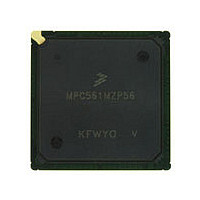MPC561MZP56 Freescale, MPC561MZP56 Datasheet - Page 902

MPC561MZP56
Manufacturer Part Number
MPC561MZP56
Description
Manufacturer
Freescale
Datasheet
1.MPC561MZP56.pdf
(1420 pages)
Specifications of MPC561MZP56
Cpu Family
MPC56x
Device Core
PowerPC
Device Core Size
32b
Frequency (max)
56MHz
Interface Type
QSPI/SCI/SPI/UART
Total Internal Ram Size
32KB
# I/os (max)
56
Number Of Timers - General Purpose
22
Operating Supply Voltage (typ)
2.6/5V
Operating Supply Voltage (max)
2.7/5.25V
Operating Supply Voltage (min)
2.5/4.75V
On-chip Adc
2(32-chx10-bit)
Instruction Set Architecture
RISC
Operating Temp Range
-40C to 125C
Operating Temperature Classification
Automotive
Mounting
Surface Mount
Pin Count
388
Package Type
BGA
Program Memory Type
ROMLess
Program Memory Size
Not Required
Lead Free Status / RoHS Status
Not Compliant
Available stocks
Company
Part Number
Manufacturer
Quantity
Price
Company:
Part Number:
MPC561MZP56
Manufacturer:
Freescale Semiconductor
Quantity:
10 000
Company:
Part Number:
MPC561MZP56R2
Manufacturer:
Freescale Semiconductor
Quantity:
10 000
- Current page: 902 of 1420
- Download datasheet (11Mb)
CALRAM Operation
22.4.5
Stop Operation
The low power stop mode for this module is entered by setting the disable bit (DIS) in the CRAMMCR
register. Reads from and writes to the array during this mode will generate an error.
When the disable bit (DIS) is cleared, the module returns to normal function.
22.4.6
Overlay Mode Operation
For a microcontroller used as a controller for an engine (or other electromechanical device), various
parameters stored in the Flash memory may need to be changed in order to properly tune (calibrate) the
engine. Because Flash memory may not be readily programmed during normal operation of an embedded
controller, portions of the CALRAM array can be overlayed onto the U-bus Flash memory. By allowing
the CALRAM module to overlay portions of Flash memory, parameters normally stored in the Flash may
be tweaked and changed with a development tool both during normal operation and prior to programming
a final, more precise version of the Flash memory.
The overlay is for read-only data and does not affect instruction fetches from the Flash. The data for any
L-bus address which falls in the overlay region of the U-bus Flash will be driven by the CALRAM on the
L-bus. The CALRAM also indicates to the L2U to block the data from the Flash to be driven onto the
L-bus. As far as the RCPU core is concerned, the timing of data coming from the CALRAM appears to be
the same as that from the Flash.
22.4.6.1
Overlay Mode Configuration
Each CALRAM module contains eight overlay regions, each of which is 512 bytes long as shown in
Figure
22-4. All overlay regions of a module are contiguous and each starts at the least significant address
of the region and can increment all the way up to 512 bytes as shown in
Figure
22-5. As described in
section
Section 22.5.2, “CALRAM Region Base Address Registers
(CRAM_RBAx)”, CRAM_RBAx
registers allow the programming of the base addresses RBA[11:29] of the U-bus Flash regions and the
RGN_SIZE[0:4] to be overlaid. Note that each region can also be individually disabled by writing 0000 to
RGN_SIZE[0:3]. If the programmed base address is not naturally aligned with respect to the RGN_SIZE
field, the least significant bits of the base address fields can be considered 0’s in order to make the starting
address naturally aligned. In an RBA register, RGN_SIZE[0:3] ={0101} select the size to be 128 bytes,
and even if CRAM_RBAx [25:29] are not all 0’s, they will be considered as 0’s so that the address
becomes 128-byte naturally aligned.
MPC561/MPC563 Reference Manual, Rev. 1.2
22-6
Freescale Semiconductor
Related parts for MPC561MZP56
Image
Part Number
Description
Manufacturer
Datasheet
Request
R

Part Number:
Description:
MPC5 1K0 5%
Manufacturer:
TE Connectivity
Datasheet:

Part Number:
Description:
MPC5 500R 5%
Manufacturer:
TE Connectivity
Datasheet:

Part Number:
Description:
MPC5 5K0 5%
Manufacturer:
Tyco Electronics
Datasheet:

Part Number:
Description:
MPC5 5R0 5%
Manufacturer:
Tyco Electronics
Datasheet:

Part Number:
Description:
MPC5 50K 5%
Manufacturer:
Tyco Electronics
Datasheet:

Part Number:
Description:
MPC5 1R0 5%
Manufacturer:
Tyco Electronics
Datasheet:

Part Number:
Description:
TOWER ELEVATOR BOARDS HARDWARE
Manufacturer:
Freescale Semiconductor
Datasheet:

Part Number:
Description:
TOWER SERIAL I/O HARDWARE
Manufacturer:
Freescale Semiconductor
Datasheet:

Part Number:
Description:
LCD MODULE FOR TWR SYSTEM
Manufacturer:
Freescale Semiconductor
Datasheet:

Part Number:
Description:
DAUGHTER LCD WVGA I.MX51
Manufacturer:
Freescale Semiconductor
Datasheet:

Part Number:
Description:
TOWER SYSTEM BOARD MPC5125
Manufacturer:
Freescale Semiconductor
Datasheet:












